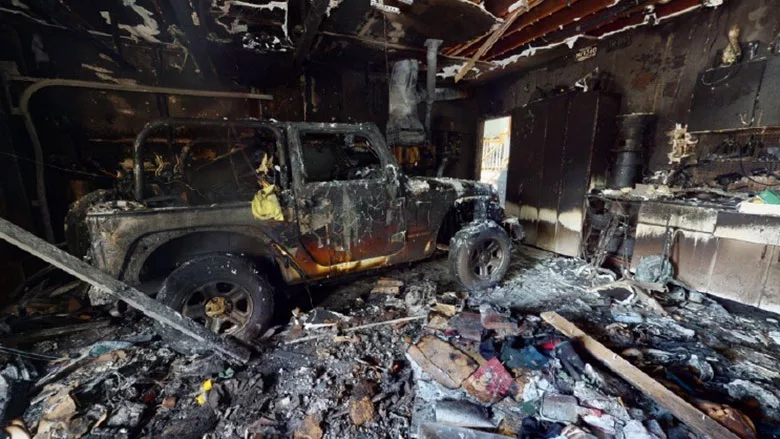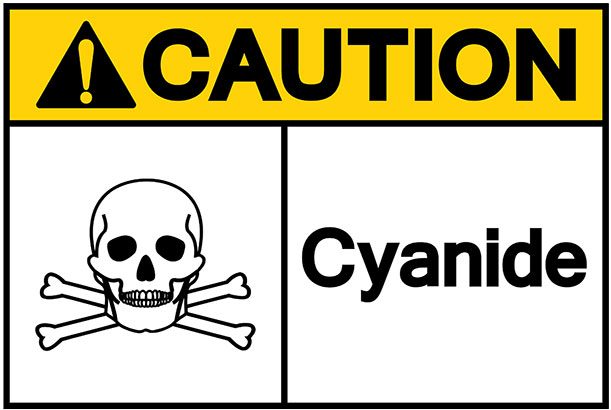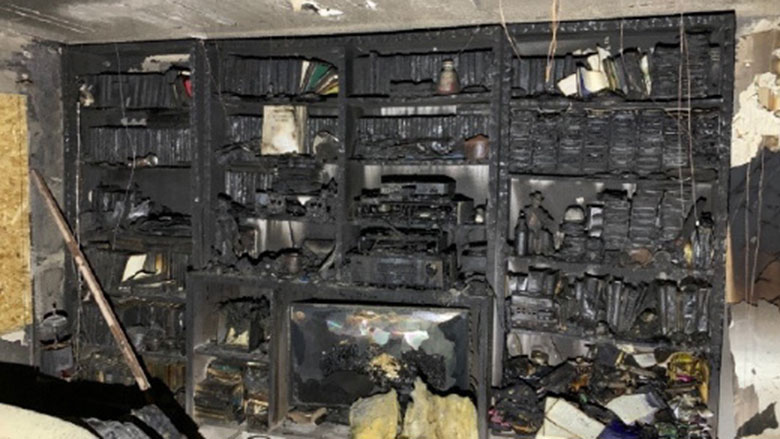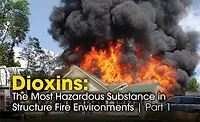Cyanide Residues in Fire Damaged Buildings

Photo credit: Sean M. Scott
During a structure fire, toxic gases, acids, VOC’s, and a vast array of other hazardous chemicals are created. These byproducts of incomplete combustion make up the composition of smoke, soot, and particulate matter. Smoke also contains moisture vapor that will condense on cool surfaces as the smoke migrates away from the fire.(1)
One of the most toxic gases found in structure fire environments is Hydrogen Cyanide (HCN). Classified as an asphyxiant or suffocating gas, HCN and its toxic twin Carbon Monoxide are responsible for the vast majority of smoke inhalation deaths in residential fires. HCN is generated when materials containing nitrogen burn or melt and release HCN gas. Some of the most common materials that release HCN in fires include:
- Natural fibers used in textiles such as wool, silk, and cotton (2)
- Plastics and Polymers (3)
- Nylon and Acrylic Fibers (4, 5)
- Melamine used in furniture and cabinetry (6)
- Acrylonitrile-Butadiene-Styrene (ABS) used in pipes (7)
- Polyurethane Foam and Foam Insulation (8)
- Upholstered furniture, Bedding, and Mattresses (9)
When HCN gas comes in contact with humidity or moisture, it can form hydrocyanic acid (HCN + H₂O → HCN(aq). If surfaces or materials are exposed to HCN gas or its aqueous form, they can become contaminated with cyanide.
Hydrocyanic acid can also evaporate, leaving behind cyanide salt residues. The extent of contamination depends on factors like humidity levels, composition of the materials that burned, surface properties, air flow, and duration of exposure. (12,13) Residues of HCN can also attach to smoke particles, remain suspended in the air, and settle on surfaces.
Facts about Hydrogen Cyanide:
- The word cyanide comes from the Greek word ”kyanos”, meaning 'dark blue'.
- HCN is 35 times more toxic than Carbon Monoxide.
- Hydrogen cyanide is lighter than air.
- It was used during World War I as a chemical warfare agent and in gas-chamber executions.
- It can enter the body by absorption, inhalation or ingestion and targets the heart and brain.
- Even low levels of HCN can be lethal over time.
- It degrades slowly in the atmosphere and can travel long distances.
- HCN is more toxic than solid cyanide compounds due to its volatile nature. (14)
Hydrogen cyanide is readily absorbed from the lungs; symptoms of poisoning begin within seconds to minutes. The odor of hydrogen cyanide is detectable at 2-10 ppm (OSHA’s Permissible Exposure Limit is 10 ppm), but does not provide adequate warning of hazardous concentrations. Perception of the odor is a genetic trait (20-40% of the general population cannot detect hydrogen cyanide); also, rapid olfactory fatigue can occur. (15)
Exposure by any route may cause systemic effects. Some common symptoms associated with HCN poisoning include: (16)

Photo: Getty Images
- Weakness/dizziness
- Flushing of the skin
- Rapid breathing
- Anxiety/excitement
- Perspiration
- Vertigo
- Headache
- Drowsiness
- Ventricular fibrillation/tachycardia
- Tremors
- Irregular or rapid heartbeat
- Convulsions
- Stupor
- Paralysis
- Coma
- Difficulty breathing/respiratory arrest
- Heart attack
Textiles Contaminated with Cyanide Residues
According to the Agency for Toxic Substances and Disease Registry (ATSDR), persons whose clothing or skin is contaminated with cyanide can secondarily contaminate others by direct contact or through off-gassing vapor. (17)
In order to protect the health and welfare of others, any clothing exposed to HCN or suspected of containing cyanide residues should NOT be cleaned. Generally, textiles contaminated by HCN, especially clothing should be treated the same way as clothing contaminated with heavy metals, asbestos, mold, sewage, blood borne pathogens, or other hazardous substances.
According to the CDC, textiles that may have been exposed to cyanide or cyanide residues should be double bagged and discarded. The CDC further states: “Do not put the bags in the regular trash! Place the bags in an area where other people are unlikely to disturb them and come in contact with cyanide. Inform local authorities of the location of the bags for pick up.” (18)

Photo: Wikimedia Commons/Public Domain
Children exposed to the same levels of HCN as adults through contact with contaminated clothing may receive larger doses. More importantly, skin or eye absorption is rapid and contributes to systemic poisoning. After skin exposure, onset of symptoms may be immediate or delayed for 30-60 minutes. Children are more vulnerable to toxicants absorbed through the skin because of their relatively larger surface area to body weight ratio.(19)
Keep in mind that even low levels of chronic exposure to HCN can have serious health implications. (20)
Testing Should Not Be an Option
If you are going to be involved in fire restoration, you will need to consider engaging an independent environmental professional (IEP). Whether you wish to embark on structural restoration or contents restoration, the role and benefits of the IEP are twofold. First, the IEP can conduct testing for potentially hazardous chemicals and gases in the workspace before work begins. This lets the restorer know what environmental hazards may be present. This testing also enhances the initial jobsite hazard analysis and helps create a safe work environment. Secondly, an IEP can provide clearance testing that will tell the restorer whether their restoration/cleaning efforts were successful. This is the same concept used today for most mold remediation projects, lead and asbestos abatement, sewage and meth lab clean up, etc.

Photo: Sean M. Scott
Protect Yourself From Liability
Typically, when restoration practitioners are in the process of selling a fire restoration project, most will guarantee their customers that when the work is completed, the building and/or personal property will be clean, smoke odor free, and restored to a pre-loss condition. This is typically based on a visual assessment and a “sniff test” once clothing is returned and just before the occupants are ready to move back into the building. However, when a customer says they smell smoke, especially on their clothing, develops a rash, or complains of a weird chemical odor, the restorer gets caught with their pants down. Here is when the restorer can end up paying to have work done over, refunding the money spent on failed cleaning and deodorization, or looking down the barrel of a lawsuit.
As people are becoming more and more educated about the toxicity of combustion byproducts, it is only a matter of time before property owners will demand proof that their home, building, or personal property are free of toxic combustion byproducts. This is where an IEP can prove to be the restorer’s greatest ally.
The Culture Has to Change
Most restorers wouldn’t think of getting involved with a mold, lead, asbestos, or sewage remediation job without the involvement of an IEP. In these types of projects, relying on a visual or olfactory assessment to prove your work was done properly would be the equivalent of committing occupational suicide. Many of the toxic byproducts generated in structure fires today, including HCN are far more hazardous to human health than most realize.
Here are some OSHA regulations and comments that support testing post-structure fire workspaces:
- OSHA regulation 1910.134(d)(1)(iii) states: The employer shall identify and evaluate the respiratory hazard(s) in the workplace; this evaluation shall include a reasonable estimate of employee exposures to respiratory hazard(s) and an identification of the contaminant's chemical state and physical form. Where the employer cannot identify or reasonably estimate the employee exposure, the employer shall consider the atmosphere to be immediately dangerous to life and health (IDLH).
- OSHA has established limits of exposure to hazardous chemicals, including combustion byproducts known as permissible exposure limits (PEL’s). A comprehensive list of these chemicals can be found at https://www.dir.ca.gov/title8/5155table_ac1.html#_blank. Testing is necessary to determine if concentrations of toxic chemicals and/or VOC’s contained in the smoke or particulate matter exceed the PEL’s. This is necessary for the health and safety of both workers and occupants.
- Restorers need to know what volatile organic compounds (VOC's) and chemicals they are dealing with to avoid creating additional toxic byproducts or chemical reactions when introducing cleaning agents or oxidizing gases.
- Every fire is unique and it is virtually impossible to know what may have burned without testing.
- Some toxic VOCs and particulate matter are odorless and can’t be detected by the sense of smell. Exposure to these chemicals can be extremely hazardous to at-risk individuals with respiratory or cardiovascular ailments.
- OSHA regulation 1910.120(h)(1)(i) states: “Monitoring shall be performed in accordance with this paragraph where there may be a question of employee exposure to hazardous concentrations of hazardous substances in order to assure proper selection of engineering controls, work practices and personal protective equipment so that employees are not exposed to levels which exceed permissible exposure limits, or published exposure levels if there are no permissible exposure limits, for hazardous substances.”
- OSHA regulation 1910.120(h)(1)(ii) states: “Air monitoring shall be used to identify and quantify airborne levels of hazardous substances and safety and health hazards in order to determine the appropriate level of employee protection needed on site.”
- OSHA regulation 1910.120(h)(2) states: “Initial entry. Upon initial entry, representative air monitoring shall be conducted to identify any IDLH condition, exposure over permissible exposure limits or published exposure levels, exposure over a radioactive material's dose limits or other dangerous condition such as the presence of flammable atmospheres, oxygen-deficient environments.”
- Restorers are often exposed to the same hazardous chemicals and gases as fire investigators who work in warm and/or cold fire scenes. Given the increasing mortality rate of those in the fire service resulting from exposure to toxic combustion byproducts, restorers need to take the necessary precautions to protect themselves, their workers, and occupants.
From the employer’s perspective, having an IEP involved from the beginning protects workers from potential health hazards and shields the employer from liability. Conducting a post-remediation verification or “clearance test” prior to new materials being installed provides the customer and the restorer with scientific proof that the work was done properly, which also helps shield the restorer from problems later on.
Sources:
- National Research Council Canada: https://web.mit.edu/parmstr/Public/NRCan/CanBldgDigests/cbd144_e.html
- Fire Engineering “Hydrogen Cyanide: New Concerns for Firefighting and Medical Tactics”: https://www.fireengineering.com/firefighting/hydrogen-cyanide-new-concerns-for-firefighting-and-medical-tactics/
- National Library of Medicine “Cyanide intoxication as part of smoke inhalation - a review on diagnosis and treatment from the emergency perspective”: https://www.ncbi.nlm.nih.gov/pmc/articles/PMC3058018/#:~:text=The%20most%20common%20occurrence%20of%20cyanide%20poisoning&text=HCN%20is%20developed%20from%20an,wool%206300%20%CE%BCg%20HCN%2Fg.
- Firehouse Magazine “Hydrogen Cyanide: The Real Killer Among Fire Gases”: https://www.firehouse.com/rescue/article/10502165/hydrogen-cyanide-the-real-killer-among-fire-gases
- National Research Counsil Canada: https://web.mit.edu/parmstr/Public/NRCan/CanBldgDigests/cbd144_e.html
- World Health Organization – International Programme on Chemical Safety: https://inchem.org/documents/icsc/icsc/eics1154.htm
- National Library of Medicine “Compound Summary on Acrylonitrile Butadiene Styrene”: https://pubchem.ncbi.nlm.nih.gov/compound/acrylonitrile%20butadiene%20styrene
- Fire Science Reviews “The fire toxicity of polyurethane foams”: The fire toxicity of polyurethane foams | Fire Science Reviews | Full Text (springeropen.com)
- Journal of Emergency Medical Services “How Fires Produce Cyanide”: https://www.jems.com/operations/how-fires-produce-cyanide/
- U.S. Department of Homeland Security – Science & Technology “Feature Article: Quickly Detecting Cyanide Poisoning After Fires Can Save Lives”: https://www.dhs.gov/science-and-technology/news/2021/09/07/feature-article-quickly-detecting-cyanide-poisoning-after-fires-can-save-lives
- University Scholl of Maryland School of pharmacy – Tox Tidbits “Enclosed Space Fires and Cyanide Poisoning” chrome-extension://efaidnbmnnnibpcajpcglclefindmkaj/https://archive.hshsl.umaryland.edu/bitstream/handle/10713/8446/ToxTidbitsMarch2019.pdf?sequence=8
- The American Conference of Governmental Industrial Hygienists (ACGIH) “Hydrogen Cyanide & Cyanide Salts”: https://www.acgih.org/hydrogen-cyanide-and-cyanide-salts/
- EPA “Toxicological Review of Hydrogen Cyanide and Cyanide Salts” 2010: chrome-extension://efaidnbmnnnibpcajpcglclefindmkaj/https://cfpub.epa.gov/ncea/iris/iris_documents/documents/toxreviews/0060tr.pdf
- European Molecular Biology Laboratory “Hydrogen Cyanide” https://www.ebi.ac.uk/chebi/searchId.do;jsessionid=1F23D996FD29FDB23BC737A861F23F3E?chebiId=18407&structureView=applet&viewTermLineage=false
- Agency for Toxic Substances and Disease Registry “Medical Management Guidelines for Hydrogen Cyanide”: https://wwwn.cdc.gov/TSP/MMG/MMGDetails.aspx?mmgid=1073&toxid=19
- Firefighting In Canada “Hydrogen Cyanide: Deadly HCN gas in Fire Smoke Threatens Responders”: https://www.firefightingincanada.com/hydrogen-cyanide-june-2007-1254/
- Agency for Toxic Substances and Disease Registry (ATSDR) “Medical Management Guidelines for Hydrogen Cyanide”: https://wwwn.cdc.gov/TSP/MMG/MMGDetails.aspx?mmgid=1073&toxid=19#:~:text=A%20victim%20exposed%20to%20hydrogen,or%20through%20off%2Dgassing%20vapor.
- Centers for Disease Control & Prevention (CDC) “Cyanide: Exposure, Decontamination, Treatment”: https://www.cdc.gov/chemicalemergencies/factsheets/cyanide.html
- Agency for Toxic Substances and Disease Registry (ATSDR) “Medical Management Guidelines for Hydrogen Cyanide”: https://wwwn.cdc.gov/TSP/MMG/MMGDetails.aspx?mmgid=1073&toxid=19
- Agency for Toxic Substances and Disease Registry (ATSDR) “ToxFAQs™ for Cyanide for Cyanide”: https://wwwn.cdc.gov/TSP/ToxFAQs/ToxFAQsDetails.aspx?faqid=71&toxid=19
Looking for a reprint of this article?
From high-res PDFs to custom plaques, order your copy today!








